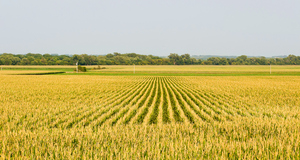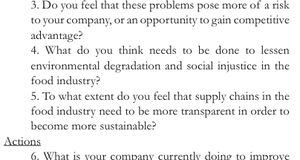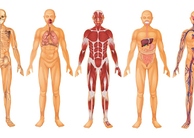Student VoicesThe Consequences of Food WasteGrowing Waste From SeedFood waste begins on farms from the very moment seeds are placed into the ground. While farmers have always needed to take into account the possibility of natural disasters such as drought, pests, or disease, modern farmers in the developed world are placed under considerable additional pressure from the supermarkets and manufactures they service. Regardless of unforeseen natural circumstances, farmers must agree to terms set by supermarkets and manufacturers, agreeing to provide an established amount of produce, resulting in farmers overplanting in order to fulfill demand. For example, a British carrot farmer who sells to the UK supermarket chain ASDA purposely plants up to 25% more carrots than needed in order to ensure he meets ASDA’s demand, meanwhile knowing that for every carrot consumed another is thrown away (Stuart, 2009). Feeding America estimates that “more than 6 billion pounds of fresh produce go unharvested or unsold each year” within the United States (Gunders, 2012). The overproduction of fresh produce allows for a margin of error in case of natural disturbances, yet this method of overplanting still cannot ensure that farmers meet supermarket demands. Supermarkets’ strict cosmetic requirements set the standard for all produce, demanding that all items maintain a certain strict aesthetic. Severe and unreasonable western standards demand uniform produce that meets requirements of length, heft and color, resulting in “some farmers [losing] up to a third of their harvest every year” (Stuart, 2009). Carrots, for example, must be straight and vibrant in color; forked carrots and their orange brethren that do not meet these standards cannot be sold and are often left to waste. Apples, kiwis, citrus fruit, nectarines, peaches, grapes, tomatoes, lettuces, strawberries and pears are all subject to these same strict cosmetic regulations that require produce to be of specific weight and without (natural) blemishes such as spots or small bruises. These absurd regulations result in large amounts of waste while hurting farmers’ bottom lines. One pear farmer with over 20,000 pear trees estimates that roughly 5 tons of his harvest are typically left in the field to rot (Bloom, 2010). In the U.K., “a third to a half of vegetables grown for supermarkets are rejected, largely because of the tight specification[s] regarding size, blemishes and appearance” (Stuart,2009). Victim to the whims of supermarkets and the consumers they feed, farmers sit at the beginning of a cycle of superfluous waste. Exploitative business relationships between food factories and super markets enable supermarkets to bargain for advantageous business deals. Typically, a manufacturer supplies products to between one to three supermarkets, making food factories utterly dependent upon their few customers. In contrast, supermarkets may have innumerable suppliers, allowing them to painlessly switch between manufacturing companies (Stuart, 2009). This dictatorial business relationship enables supermarkets to restrict suppliers and grants them the power to change orders at the last minute, resulting in excess amounts of pre-made and pre-packaged food that is forbidden from being sold elsewhere or donated due to supplier food carrying supermarket labels and logos (Stuart, 2009). With one or two individual supermarkets controlling the commerce of an entire manufacturing factory, suppliers have little choice but to heed supermarket demands or face bankruptcy. Marks & Spencer, an all-purpose supermarket requires one of their chief sandwich suppliers to discard four slices of bread per loaf, the crust and first slice off both ends of the loaf, amounting to roughly 13,000 slices of edible bread, wasted, every day (Stuart, 2009). The food wasted during manufacturing means that untold amounts of energy and resources are expended in the creation of food that is never even served.Underneath the pristine appearance of the supermarket lies a seedy underbelly of waste and excess. Catering to consumer demands, supermarkets purposely overstock shelves in order to provide the façade of limitless abundance. The commercial food landscape leads to the disposal of unsold (but still edible) produce that surpasses the “sell-by” date or items that are excessively handled or bruised by browsing buyers. Various unregulated “use by,” “best by,” and “sell by” stamps are not an indication of food safety but are instead suggestions for peak quality, even though these dates are commonly stamped indiscriminately onto both perishable and nonperishable items (Gunders, 2012). These dates confuse customers, who believe that these marked dates are an indication of food safety and lead to many people disposing of food once the expiration date is hit. In addition to unwanted surplus stock and “sell-by” date confusion, supermarkets also repeatedly throw out food whose packaging has been damaged; “If one item within a larger pack is blemished, the whole pack will generally be chucked out” (Stuart, 2009). The monetary loss as a consequence of surplus foodstuffs, damaged packaging, rotten fruit and surpassed sell by dates is recouped by jacking up the retail price of “any item [to] two to three times the cost price, which means that it is better to waste two of each product than lose even just one sale by selling out of it” (Stuart, 2009). Supermarkets have turned the wasting of food into a financial gain; not only do they benefit from overstocked shelves but the selling of aesthetic produce is more profitable than selling cheaper and “uglier” produce, although both are likely identical in taste and nutrition. Workers in major supermarkets report that, for example, the chain’s deli department was required to dispose of half of all the rotisserie chickens cooked in a day; after three hours of sitting, the chickens were marked down and after four they were thrown away, only to be replaced with freshly cooked chickens (Bloom, 2010). This senseless waste of edible food could be avoided either by allowing employees or food banks to take excess food. Nevertheless, supermarket managers often refuse to grant either employees, charities, or homeless shelters access to the food out of fear of lawsuits should anyone fall ill due to eating the extra food (Stuart, 2009). An estimate by the USDA suggests that supermarkets lose upwards of 15 billion dollars annually due to unsold fruits and vegetables alone (Gunders, 2012). The lavish food landscapes of modern supermarkets make affluent consumers apathetic to food and food waste as so much food is quietly discarded. The cornucopia of supermarkets suffocates and overwhelms patrons, awakening every omnivore’s dilemma: what in the world shall I eat? (Pollan, 2006) As a privileged nation, the United States has forgotten how to eat: “we’re uncertain when foods have gone bad, and when we aren’t sure, they’re tossed” (Bloom, 2010). We know nothing about the food we use to sustain ourselves and are slowly losing our ability to cook for ourselves. Demand for convenience foods has reduced the amount of time adults spend actively preparing food. Time-use studies reveal that the amount of time spent per day “on cooking and cleaning at home was reduced from 65 minutes to 31 minutes” between the years of 1965 and 1995 (Canning, Charles, Huang, Polenske, Water, 2010). Lacking a food culture or appreciation for food, consumers in prosperous countries such as the United States and Great Britain have distanced themselves from their agrarian roots, viewing food not as a gift but as a commodity used only to overstuff already overflowing stomachs. Average American families throw out over 25% of purchased food and beverages, amounting to between $1,365 and $2,275 in wasted food for an average family of four every year (Gunders, 2012). There is an established cycle of waste found within the privileged ‘global north.’ Waste from farmers, suppliers, supermarkets and consumers are all individual points in the waste sequence, but all are intricately connected. Remedying the Waste ProblemWith roughly 35 million U.S citizens suffering from hunger, the United States could help reduce unnecessary waste by salvaging foodstuffs left over from farmers and supermarkets and providing this leftover food to shelters and the poor (Stuart, 2009). Gleaning is not a new or revolutionary idea. This practice of collecting post-harvest produce is documented as far back as the Old Testament. Renewing the practice of gleaning would feed numerous hungry people while helping to prevent high-quality and nutritious food from ending up in landfills. As reported by the USDA’s food and recovery coordinator, in one year alone 3,647,595 pounds of gleaned food were saved from landfills and donated to charities and food shelves (Bloom, 2010). Utilizing left over “ugly” produce from fields and surplus food from supermarkets would help to alleviate hunger and waste within the United States and other countries. Small, eco-friendly food businesses are already moving toward reducing waste and feeding more people. Converting popular opinion of food waste from valueless waste into viewing food scraps as renewable, raw material to “develop high additive value as new products” could transform food waste into new business initiatives (Oreopoulou & Russ, 2007). By-products such as spent grains, carrot shavings and other assorted vegetable and fruit peels are often tossed, but within these by-products lay great potential from dietary and financial gain from less conventional uses. Carrot waste and spent grain can be converted to fiber for human consumption, while “soluble and insoluble fiber from apple, tomatoes, and carrot waste, as well as peels from citrus fruit, can be extracted in various classes [. . .] to bind water in foods due to their absorptive properties and ability to form gels” (Oreopoulou & Russ, 2007). Whey, a by-product of straining milk and cheese-making can be used as an additive in crackers, breads, processed foods and commercial pastries as well as in beverages that contain whey (Oreopoulou & Russ, 2007). Using by-products to produce additives such as fiber and oils is one means of transforming waste food material into usable, sellable, renewable materials that are fit for human consumptions; yet there are many other possibilities for waste food. Materials from food waste have potential for a variety of products and can also serve as more unusual additives. Beyond mere additives for food, the fibrous materials found in spent grains can also be employed as filler and structural material in building materials such as fiber board and brick. Fibers found in brewery waste help to strengthen bricks “before they are kilned. Because they burn away during the kiln process and form pores in the bricks, they increase the bricks’ ability to thermally insulate” (Oreopoulou & Russ, 2007). Furthermore, fat, a by-product of slaughterhouse waste is often used “as a basis for many products in the chemical and cosmetic industries” (Oreopoulou & Russ, 2007). Clearly, it is possible not only to eat waste food but to build with it and wear it as well! Treating food waste not as a valueless by-product but instead as a renewable resource capable of fulfilling multiple purposes will help to lessen waste and improve the efficiency of food networks. Employing food waste as a source of animal fodder is yet another method of bolstering food system efficiency while simultaneously reusing food that would have otherwise gone to landfills. Throughout history, farmers almost always supplemented their pigs’ feeding troughs with whey or “slop,” left over kitchen scraps and plate waste. Feeding pigs food leftovers is a sustainable means of supplementing a grain-based pig diet by providing various vitamins, minerals and proteins. Over the past 75 year numerous experiments “have shown that proper supplementation improves the performance of food waste-fed pigs (even when food waste is of very poor quality) to levels similar to grain-fed animals” (Westendorf, 2000). As mandated by the 1980 Swine Health Protection Act, waste that is to be fed to pigs must be treated and heated beforehand yet this practice of feeding food waste to swine has been in decline. Yet the plate waste which accumulates in resorts, restaurants and hotels is enough to supplement swine diets; as farmers “in the vicinity of Secaucus, in Hudson County” were able to feed over 25,000 pigs off of hotel waste acquired from New York, Newark and Jersey City alone (Westendorf, 2000). Through additives and animal feed, food waste can be reintroduced into the food system, increasing the efficiency and bolstering the sustainability of food networks. Food waste that is difficult or impossible to use as animal fodder, such as food scraps with high mineral content can be used to revert the cycle of soil damage caused by agriculture (Oreopoulou & Russ, 2007). Anaerobic decomposition of uneaten food attributes roughly 23% of all methane emissions in the United States and “of all the food that is lost at different stages from farm to fork, only 3 percent is composted” (Gunders, 2012). Pomace, the solid remains (skins, stems, pulp and seeds) of fruits pressed for oil, such as grapes, olives along with hop waste from brewing is unfit for animal consumption but can be either used as organic fertilizer or composted (Oreopoulou & Russ, 2007). Compost, the aerobic stabilization of solid, organic matter prevents the formulation of methane, while instantaneously strengthening the fertility of the soil. As an organic substitute for synthetic fertilizers, compost improves “soil tilth condition and structure,” enhances the soil’s ability to hold nutrients and water, nourishes microscopic soil organisms, helps dissolve soil minerals, protects against chemical imbalances, provides “biological control of certain soil pests” and encourages organic materials to return to the soil, inhibiting organic materials from leaching into waterways and landfills (Oreopoulou & Russ, 2007). Recycling food waste into a soil material fortifier reduces carbon dioxide and methane emissions by preventing food from being dumped in landfills and it revitalizes abused and misused soil.Continued on Next Page » Suggested Reading from Inquiries Journal
Inquiries Journal provides undergraduate and graduate students around the world a platform for the wide dissemination of academic work over a range of core disciplines. Representing the work of students from hundreds of institutions around the globe, Inquiries Journal's large database of academic articles is completely free. Learn more | Blog | Submit Latest in Opinion |
















